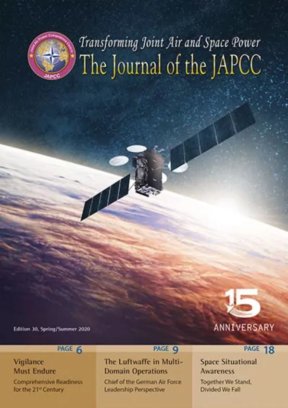Introduction
The NATO Alliance Ground Surveillance Force (NAGSF) is a ‘quantum leap’ in NATO’s Intelligence, Surveillance & Reconnaissance (ISR) capabilities, with unprecedented integration to benefit NATO and all 30 Alliance nations. It is the world’s most advanced integrated air-ground surveillance system, due to its unique combination of multi-domain intelligence operations expeditionary and reach-back Processing, Exploitation, and Dissemination (PED) capabilities, on-site schoolhouse and experienced multinational team, with military and civilian experts from across the Alliance.
NAGSF has multiple capabilities, including five Global Hawk (RQ-4D) ‘Phoenix’ aircraft for organic collection; a robust PED element capable of both fixed and expeditionary operations and an organic training centre that covers all major functions within the organization. NAGSF embodies NATO’s continued commitment to strengthen our deterrence and defence readiness and will be active throughout the Joint ISR environment.
Aircraft
The NAGSF aircraft are large, highly advanced ISR platforms with unmatched operational altitude, sensor standoff, and mission endurance. Launching from Sigonella Air Base, Italy, the aircraft will execute missions between 50,000–60,000 feet within friendly and/or international airspace, utilizing their Synthetic Aperture Radar (SAR) to collect imagery and ground movement data throughout their over 30-hour flight duration.
The sensors on the NAGSF aircraft provide an all-weather, wide-area collection capability that perfectly complements the airframe’s high operational altitude and supreme endurance. Due to the sensor’s ability to collect imagery and track movement deep within contested or denied territory, the aircraft can effectively collect on targets and surveil wide areas while remaining in non-hostile airspace. The aircraft have Link-16 capability for improved situational awareness and an Automatic Identification System, which affords them an expanded capability for maritime domain mission sets.
Intelligence Processing, Exploitation, and Dissemination
NAGSF has already achieved an initial PED capability. With the arrival of the full system and the integration of data from Alliance nations, the Joint and federated ISR output will become more robust and comprehensive to meet the needs of the Alliance. The PED Centre will become a focal point for providing senior military and political leaders with critical intelligence to inform their decisions. The NAGSF Operations Centre (NAOC) will be the hub of both air operations and federated PED activity. This centre also includes the ability to synchronize fixed and expeditionary PED and Command and Control capabilities.
- Fixed: An imagery exploitation capability that provides single-source and fused intelligence products from a fixed location at the Main Operating Base in Sigonella. The collection, data storage, and sharing mechanisms employed by NAGSF will enhance NATO nations’ access to intelligence data not otherwise available. This adds to an operational approach that expands on nationally gathered intelligence, which will, in turn, increase the Alliance’s readiness. Overall, this is a key tool that enables a collective defence effort by furthering the production and sharing of Joint ISR data throughout NATO and its member nations.
- Expeditionary: Deployable ground assets consisting of several mobile systems comprised of imagery exploitation and communications capabilities. This capability is scalable, with assets equipped to support tactical to theatre-level operations. This expeditionary capability provides ground commanders near-real-time intelligence and a node that enables ground-level situational awareness required for a readied posture.
Training and Personnel
NAGSF is composed of experts from 18 different national forces with significant experience operating and maintaining high-altitude Remotely Piloted Aircraft (RPAs). Many have flown RPAs in European airspace with their national militaries. These motivated, handpicked high altitude experts have been placed in key operations and maintenance billets to ensure a successful and rapid operationalization of this capability.
Long-term, NAGSF plans to grow its training cadre into a full-fledged Training Centre capable of significant student throughput to provide an array of world-class Joint ISR courses to all NATO nations. The ultimate vision for the NAGSF Training Centre is to become a nexus of NATO’s ISR and PED knowledge and experience. The Training Centre will take students, regardless of their ties to NAGSF, and turn them into trained and qualified ISR experts to enhance both NAGSF and their home nations’ JISR effectiveness.
Additionally, a small group of NAGSF personnel are present at SHAPE and Allied Air Command (AIRCOM) Headquarters. These liaison personnel assist in furthering NATO Joint ISR Policy, RPA Integration, and participation in NATO interoperability trials, positively influencing Alliance-wide training objectives.
Mission Sets
While NAGSF is still in its formative stages of organic collection and sortie generation, the majority of its effort will focus on three main mission sets:
- Indications and Warnings (I&W): Providing the Alliance key I&W is likely to be NAGSF’s most important mission set for NATO. The aircrafts’ sensors and supreme endurance allow for wide-area collection and persistent surveillance, enabling NAGSF to monitor and identify changes in posture and asset locations to increase the ground and maritime picture situational awareness for senior political and military decision-makers.
- Crisis Response (CR): CR is an equally fitting mission set for NAGSF, to include broad area target surveillance to detect enemy forces manoeuvring across the battlefield. Utilizing the sensor’s movement tracking capabilities, NAGSF can monitor large areas and relay actionable call-outs in real-time to other Alliance assets that are capable of visually identifying unknown or hostile movers.
- Humanitarian Assistance and Disaster Relief (HA/DR): HA/DR is a less obvious, but no less important, mission for NAGSF. A combination of overhead NAGSF aircraft and deployed ground systems can provide on-scene disaster relief teams with real-time information concerning the situation on the ground. SAR imagery can provide a damage assessment of buildings and critical infrastructure, while movement indications can identify traffic patterns, road blockages, and isolated victims.
Programme Timeline and Goals
The acquisition of a programme of this scale is a first in NATO’s 70-year history and provides NATO with leading-edge strategic technology. The NAGSF programme has been in development for nearly seven years and is now transitioning from the acquisition to the operational phase, all because of the tremendous efforts of multiple stakeholders. Countless hours of work and millions of pages of documents have been written, reviewed, revised, and approved by organizations spanning nearly the whole of NATO. This has been a massive team effort between several contracting companies, multiple NATO committees, the Italian Ministry of Defence, the Italian Directorate of Air Armaments and Airworthiness (DAAA), and the 15 procuring NATO nations. A great example of the ground-breaking work accomplished through this acquisition is DAAA awarding the first-ever Military Type Certificate (MTC) in the history of aviation to a high altitude unmanned aerial system.
Two of the five RQ-4D aircraft are at Sigonella, with the other three anticipated to arrive shortly. In the meantime, NAGSF will work to become fully operational by flying sorties in support of SACEUR and NATO. NAGSF anticipates achieving full operational capability by 2022.
Conclusion
The Alliance provides an umbrella of protection for over one billion people and represents half of the world’s economic and military might. NATO continues to evolve with the changing threats and geopolitical landscape, and, by acquiring NAGSF, responded with the biggest reinforcement to our collective defence and deterrence capabilities in decades. As Secretary General Jens Stoltenberg recently stated, ‘… [NAGSF] demonstrates that NATO Allies are committed to modernizing the Alliance and investing to deliver key cutting-edge capabilities to the benefit of our shared security.’1
NAGSF is the physical manifestation of NATO’s collective defence strategy and demonstrates the Alliance’s relevance and strength against our global competitors. NATO’s first and only high altitude ISR programme is a state-of-the-art capability that brings an unprecedented leap in the Alliance’s ability to collect, process, and disseminate intelligence amongst its members. It provides a multi-domain and integrated ISR capability absent in most nations across the globe, and is a capability that Alliance nations can call upon in times of national emergency. A peaceful Europe is a prosperous Europe; a prosperous Europe is a secure Europe – NAGSF is a reflection of NATO’s commitment to this concept.












